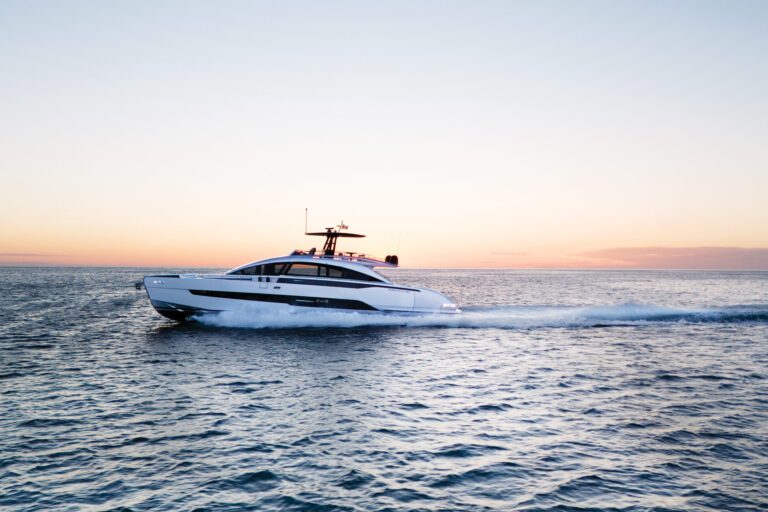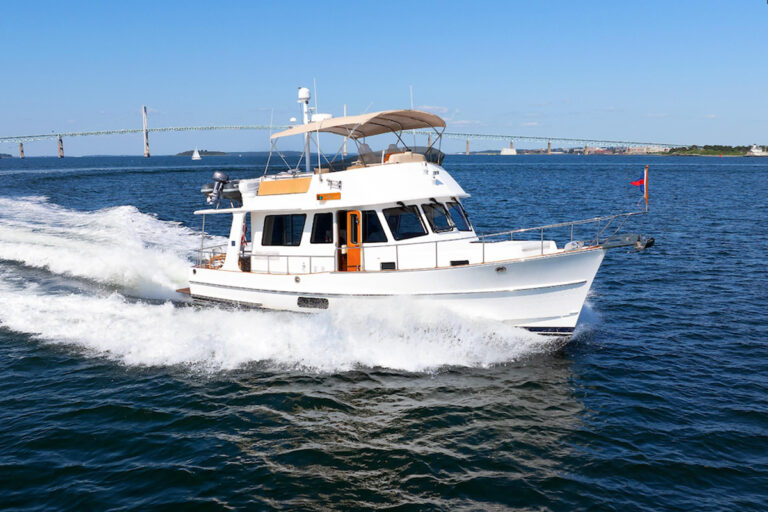Successful semi-custom yacht builders often exploit niches that larger manufacturers are unable to address. As many American yachtsmen embraced European styling in the 1990s, Horizon built its customer base delivering a similar look and feel at competitive prices.
The builder’s new 62-footer is in step with that, but with an updated look that pleases my weathered eye. She straddles the fence by being the type of boat that can accommodate a professional crew or can be operated by an experienced couple, while offering the style and luxury that attracted people to Horizon motoryachts in the first place.
“We have found that the 62 often appeals to people moving up from larger express cruisers. They are typically surprised by the amount of space and comfort a motoryacht affords”, said Don Gilman, president of Gilman Yachts, the East Coast agent for Horizon.
Curiously, the buyer of our test boat was the owner of a 70-foot Horizon who wished to move down and live without crew. In my view, she is a perfect transition yacht for folks moving in either direction.
This motoryacht is easy to move about. Her interior helm station is a step away from a cleverly designed pantograph-style door that allows quick access to the deck. Side decks will come in handy when few hands are handling lines. The afterdeck has stairs to the flying bridge, bringing closer the flying bridge’s control station and afterdeck’s remote station.
Exterior deck surfaces forward are molded nonslip, and lockers integrated into the raised trunk are handy for stowing deck gear. For the less ambitious, a sunning area is on the raised trunk. Hearty, polished stainless-steel cleats fore and aft are fitted with roller fairleads. Our test boat’s teak-finished afterdeck had a molded-in seating area and table, with port- and starboard-side access to an integral teak-covered swim platform. Optional warping windlasses aft might be a nice touch for those less able to tug lines.
The helm station on the flying bridge has enough space for the usual engine instrumentation, as well as communications gear and several large electronics displays. Though the station is comfortable, its vertical-mount wheel shadows the engine controls. A single-lever setup might be more desirable. I would also pass on the dash hood designed to cover the electronics when they are not in use. It’s a nice thought, but when I stood behind the hood (secured in the open position), it blocked my view of several instruments. Horizon offers a more conventional alternative.
Abaft the helm is a seating area with a table, wet bar, refrigerator and grill. A molded arch is standard, and a Bimini top is available. I would choose the molded fiberglass hardtop and Strataglass enclosure, $24,700 and $7,000 options, respectively. The space abaft the seating area can be fitted with sunpads or used to accommodate a crane and tender up to 12 feet.
The 62 is built in the same semi-custom environment that produced her larger sisters. While her major bulkheads and machinery space are fixed, her interior arrangement is open to interpretation.
“Many of our clients have been through the custom home-building process and seem to enjoy the same flexibility of fine-tuning the 62’s layout and interior design”, Gilman said. “While we offer a series of stock two- and three-stateroom arrangements, they serve primarily as a starting point.”
Drawings and ideas are cut and pasted in the sales office and faxed to Horizon’s engineering team for a reality check. When all are on the same page, the boat is built in about eight months.
Our test boat’s split-level deckhouse had a saloon aft followed by a galley and dinette abaft the helm station. Belowdecks, the layout was an adaptation of a stock arrangement, with a full-beam master stateroom tucked beneath the galley and dinette area. Steps lead up into the master head. A guest stateroom forward has a queen island berth and private access to the second head. A passageway divider can be closed to create a third, relatively compact cabin with a single berth. Our test boat included the optional after crew quarters in lieu of a lazarette.
Fit and finish of the cherry interior are excellent, just what I expect from Taiwan’s capable joiners. The yard’s design team prepares the 62’s interior to order, with selected soft goods, hardware, joiner design and wood. The team is also willing to work with a client’s own interior designer.
Horizon owns three yards in Taiwan, each dedicated to a different phase of construction: fiberglass lamination, assembly or outfitting. Horizon uses both hand lay-up and SCRIMP, a resin infusion process designed to optimize fiberglass-to-resin ratios. The 62’s bottom is solid fiberglass, and the hull sides, decks and superstructure are cored with Divinycell. The bottom is supported by a fiberglass stringer system, marine plywood bulkheads and web frames, and is laminated with blister-resistant resin. The hull and superstructure have an excellent gelcoat finish.
Access to machinery space is through the crew quarters or lazarette (via the swim platform). Also, the afterdeck has a hatch that provides access in inclement weather. The machinery space is reasonably tidy, and access is good. Fuel is carried in aluminum wing tanks that feed a central day tank. Most everything, from electronics to bilge pumps, is purchased in the U.S. and shipped to the yard for installation. Wiring follows ABYC standards.
While 700 hp Caterpillar C12s are standard, our test boat was fitted with optional 1,050 hp MANs. In 2- to- 4-foot seas, the 62 accelerated from full stop to full speed in 25 seconds without much fuss. She has a conventional hard-chine V-form with a moderate entry and 12.1 degrees of deadrise at the transom. Trim tabs are fitted, but they are needed only for fine-tuning, since she runs at fairly shallow trim angles. I recorded a top speed of 23.8 knots at 2400 rpm, 100 turns more than recommended. At 2100 rpm, I measured a cruising speed of 19.2 knots. Gilman has since dialed in the wheels, and he reported a top speed of 27 knots.
Yacht sales in this category seem to lean toward turnkey offerings, but Horizon has bucked the trend by establishing a base price and offering a lengthy list of options (some of which, such as air conditioning, are essential). Our test boat, with 1,050 hp MANs and upgrades for her interior, exterior and electronics, was priced at $1,521,700. This is the number to remember if, like me, you find the Horizon 62 hard to forget.
Contact: East Coast: Gilman Yachts, (561) 626-1790; www.gilmanyachts.com. West Coast: Carl French Yacht Sales, (206) 223-9333; www.cfys.com.





